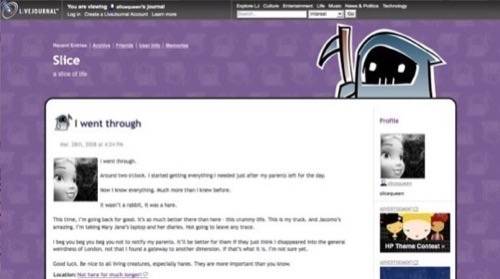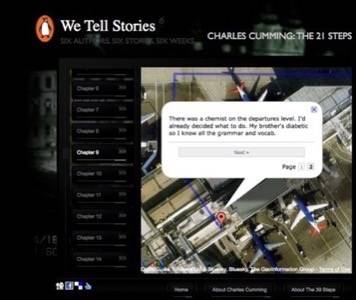
British book publishing giant Penguin is carrying out an experiment that takes six books from six different authors and distributes them through new media channels over six weeks. Called
, some people say the campaign is pure evil and others are hailing it as a sign of the future.
Two of the first weeks include serializing a story called Slice through two LiveJournal blogs and two Twitter accounts, and placing a second story called The 21 Steps on a navigable Google Map. Three stories remain and the distribution formats to be used are unannounced. (Actually, we hear now that the next step will be live performance – we’ll see what that looks like!)
Blogging and Twitter
Slice, the story of a girl and her parents, was delivered by serialized LiveJournal and Twitter postings. Now that the week has passed, it’s pretty frustrating to try to read the stories in reverse chronological order.
Apparently some of these media work better than others for story telling in real time. A mere 78 people signed up to “follow” the parents’ Twitter account, more than 110 followed the daughter. As Gawker said in its coverage – “But getting away from Twitter is exactly the reason we read books!” Said like a true Twitter user.

have a respectable if small number of comments left on them. Readers seemed dissatisfied with the end of the story and there’s one allegation of dummy accounts posting fake comments – it’s downright LonelyGirlish in tone if not in scale.
Google Maps
The other story of note so far, a thriller called The 21 Steps, is easier to read. Navigation around the map is quite controlled, though, rich media elements are minimal for the first 6 chapters (all I could get through) and the medium does slow down reading. That said, I enjoyed the birds-eye view of the places that were being written about. I might finish that story later.
Author Charles Cumming said in an interview with CoolHunting yesterday about the project that the process of writing along with game designers, within the technical limitations of Google Maps, was a positive experience.
It was limiting only in the sense that I couldn’t explore character in any great depth or get into the more psychological or emotional sides of the story. Plot was everything. Suspense was everything. It was all about pace and movement. But that in itself was quite exciting. Once I understood the parameters of what Penguin were trying to achieve, I had a lot of fun with it.
Booklist’s Keir Graff writes of the effort, “Well, it beats cell-phone novels, but I still dont think this is the fiction-delivery vehicle for me…Its an odd sensation, really: simple words can evoke a world in our imaginations, but as soon as the words are married to real-world images, they lose much of their power. Similarly, it can be fun to look at a map and imagine what the places really look like, but here, the Google satellite view just made me frustrated because I wanted to see what the place really looks like at street level and inside the buildings.”
My experience was similar.

Brady Forrest, at
, found the maps integration inspiring and started a list of other ways mapping and story telling could be put together.
I’m not sure that Google Maps alone is the best way to accomplish this goal. Forrest points to Portland mapping service Platial and it certainly seems like there’s continued opportunity for any number of startups in this space beyond Google Maps.
A Look Into the Future
The book publishing world, like so much of legacy media, is scrambling to stay relevant. We’ve written about collaborative novel writing here too, some of which has been explored by Penguin as well.
It will be interesting to see what the next three installments of We Tell Stories bring. So far none have seemed like a real winner to me. So far I’d rather see the whole book be offered for download on BitTorrent (see Laughing Squid) and then offering interactive elements to supplement the actual reading of the book. If it was good enough I’d pay for it. Most publishers would probably do well focusing for now on making their transition to a largely digital world truly good enough, if not great, and focus on making money afterwords. That might sound crazy, but it’s not as crazy as reading a novel on Twitter a week after it was published.










